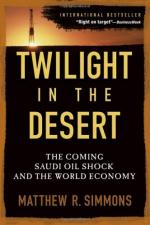
|
| Name: _________________________ | Period: ___________________ |
This test consists of 15 multiple choice questions and 5 short answer questions.
Multiple Choice Questions
1. Oil in Saudi Arabia will not last ____________.
(a) For more than a decade.
(b) Forever.
(c)
(d) Past the 22nd century.
2. A SPE paper says that the best approach to steadily increasing water cuts is to choke back what?
(a) A well's purification efforts.
(b) A well's rate of production.
(c) A well's drilling depth.
(d) A well's drilling speed.
3. In what year did geologists determine that the Arab D Zone has eroded away and been replaced by younger rock?
(a) 2000.
(b) 1996.
(c) 1998.
(d) 2002.
4. When Saudi Arabia began drilling just for natural gas, they encountered problems with sand and what?
(a) Silicate crystals.
(b) Saline water.
(c) River water.
(d) Graphite.
5. One of the discoveries made between 2004 and 2006 is known as what type of reserve?
(a) Natural gas-only.
(b) Gas-only.
(c) Crude-only.
(d) Oil-only.
6. According to Saudi Arabian officials, how long did it take before they found oil at Yerbin Field?
(a) 8 years.
(b) 7 years.
(c) 10 years.
(d) 9 years.
7. Who encourages the assumption that Saudi Arabia can continue to maintain its incredible level of oil production?
(a) International engery forecasters.
(b) International drilling companies.
(c) International oil companies.
(d) International engineering companies.
8. One paper, presented by a Saudi engineer, discusses how conventional analytical techniques are not accurately interpreting data from what type of wells?
(a) Surface wells.
(b) Shale wells.
(c) Offshore wells.
(d) Horizontal wells.
9. What word characterizes the gas initiative in Saudi Arabia?
(a) Joy.
(b) Disaster.
(c) Improvement.
(d) Recession.
10. Overproduction and what have contributed to an early decline in production in Russian oil fields?
(a) Poor management.
(b) Civil wars.
(c) Lack of technology.
(d) Damage to the surrounding areas.
11. Who printed in 2005 an article about Saudi Arabian oil fields facing challenges?
(a) The New York Times.
(b) The Economist.
(c) Newsweek.
(d) The New Yorker.
12. At the October 2003 SPE conference, how many papers were presented by Saudi Arabian authors?
(a) 9.
(b) 12.
(c) 14.
(d) 17.
13. According to the author, where does the future of Saudi Arabian oil production lay?
(a) In the offshore drilling areas.
(b) In natural gas production.
(c) In the oil left behind.
(d) In the neutral zone.
14. How much money did Saudi Arabia invest in gas processing facilities?
(a) Millions of dollars.
(b) Hundereds of thousands of dollars.
(c) Billions of dollars.
(d) Hundreds of millions of dollars.
15. Since what year has there been very little data available to verify production levels in Saudi Arabia?
(a) 1993.
(b) 1979.
(c) 1987.
(d) 1982.
Short Answer Questions
1. When can the true recoverability figures of an oil reserve be discovered?
2. Saudi Arabian officials are making impressive predictions about oil fields which have a history of what?
3. The neutral zone oil is shared between Saudi Arabia and what country?
4. When did Saudi Arabia establish the Master Gas System?
5. Instead of helping to recover more oil from older fields, technology has done what?
|
This section contains 493 words (approx. 2 pages at 300 words per page) |

|




